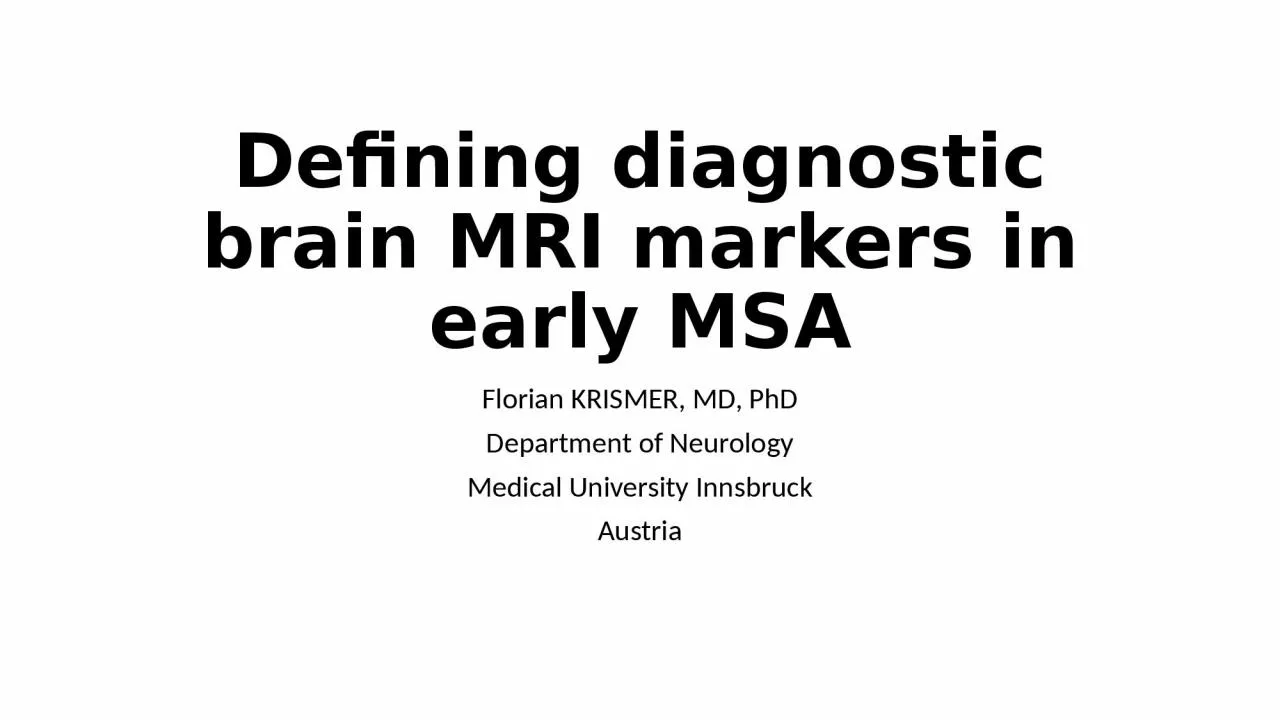

Florian KRISMER MD PhD Department of Neurology Medical University Innsbruck Austria Early diagnosis of MSA an unmet need Due to overlapping symptoms particularly in early disease stages MSA is often misdiagnosed as Parkinsons disease or other related disorders ID: 1010235
Download Presentation The PPT/PDF document "Defining diagnostic brain MRI markers in..." is the property of its rightful owner. Permission is granted to download and print the materials on this web site for personal, non-commercial use only, and to display it on your personal computer provided you do not modify the materials and that you retain all copyright notices contained in the materials. By downloading content from our website, you accept the terms of this agreement.
1. Defining diagnostic brain MRI markers in early MSAFlorian KRISMER, MD, PhDDepartment of NeurologyMedical University InnsbruckAustria
2. Early diagnosis of MSA – an unmet needDue to overlapping symptoms, particularly in early disease stages, MSA is often misdiagnosed as Parkinson’s disease or other related disordersCurrent diagnostic criteria rely primarily on clinical symptoms and physical examination.
3. Study designDevelopment of a novel MR brain atlas for automated segmentation by manually labelling relevant brain regions in 48 healthy individuals.Evaluate the diagnostic accuracy of the novel atlas for the differential diagnosis of MSA (parkinsonian and cerebellar variant) versus Parkinson’s disease in a cross-sectional study.
4. Key findings I – Automated Segmentation of the MCPKrismer et al.; Movement Disorders, Volume: 34, Issue: 7, Pages: 1041-1048, First published: 28 March 2019, DOI: (10.1002/mds.27669); https://doi.org/10.1002/mds.27669Three‐dimensional models of automatically segmented middle cerebellar peduncles (in red/orange) in a PD patient (a) and a MSA‐C patient (b).
5. Key findings II - Brain atrophy profileData points above or to the right side of the red dotted lines indicate significant brain atrophy (as compared with age-matched healthy controls)Krismer et al.; Movement Disorders, Volume: 34, Issue: 7, Pages: 1041-1048, First published: 28 March 2019, DOI: (10.1002/mds.27669); https://doi.org/10.1002/mds.27669
6. Key findings III – Diagnostic algorithmKrismer et al.; Movement Disorders, Volume: 34, Issue: 7, Pages: 1041-1048, First published: 28 March 2019, DOI: (10.1002/mds.27669); https://doi.org/10.1002/mds.27669Exploiting this algorithm 96.8% of MSA patients and all PD patients were classified correctly.
7. ConclusionsOur automated morphometric analysis corroborates previous neuropathological studies that showed that most MSA patients have a mixed striatonigral and olivopontocerebellar pathology and that brain atrophy patterns do not necessarily correspond to the clinical impression of predominant motor deficits. Automated subcortical brain segmentation accurately discriminates MSA from PD patients.The full paper is freely available from https://doi.org/10.1002/mds.27669
8. AcknowledgmentsWe are grateful to for a grant in 2015 supporting this and other related projects.